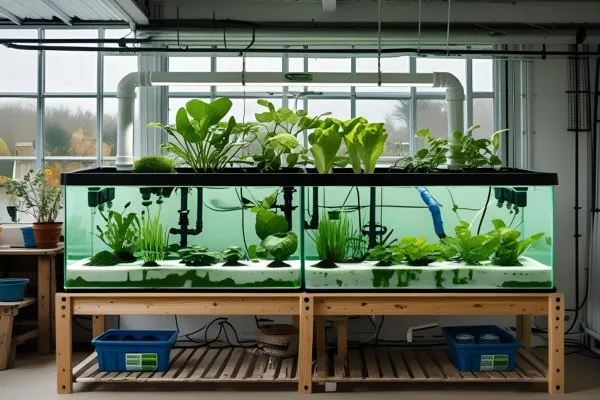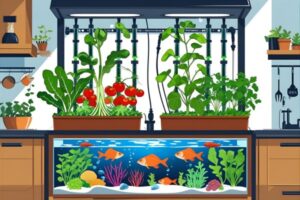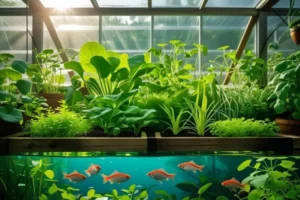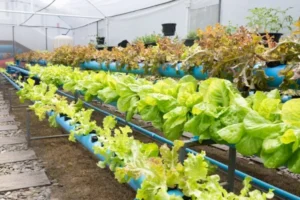Many aspiring aquaponics enthusiasts believe their systems must be elevated on tables, stands, or concrete platforms to function properly. This widespread misconception has prevented countless homeowners from installing aquaponics systems in their preferred locations, leading to unnecessary construction costs of 200 to 500 USD for elevated platforms and limiting system sizes to smaller, less productive configurations.
The confusion surrounding soil placement stems from legitimate concerns about contamination, system stability, and drainage issues. New aquaponics practitioners often worry that direct soil contact will introduce harmful bacteria, chemicals, or pests into their closed-loop systems. Others fear that ground-level installation might compromise structural integrity or create maintenance nightmares during seasonal weather changes.
However, the reality is significantly different from these common fears. Professional aquaponics operations worldwide successfully utilize ground-level installations, from small backyard systems producing 15 to 25 pounds of vegetables monthly to commercial facilities generating thousands of dollars in revenue annually. The key lies in understanding proper installation techniques, drainage management, and contamination prevention strategies.
Ground-based aquaponics systems offer numerous advantages including enhanced stability, reduced construction costs, improved accessibility for maintenance, and unlimited expansion potential. With proper preparation and installation techniques costing just 50 to 150 USD in additional materials, you can safely place your aquaponics system directly on soil while maintaining optimal water quality and system performance.
This comprehensive guide will eliminate the guesswork, providing step-by-step instructions for safe soil installation, proven drainage solutions, and professional-grade contamination prevention methods that ensure your ground-level system thrives for years to come.
Understanding Soil-Based Aquaponics Installation
The Science Behind Soil Compatibility
Aquaponics systems function as closed-loop environments where water circulates between fish tanks and growing beds without direct interaction with external soil. The confusion between “soil contact” and “soil contamination” has created unnecessary barriers for ground-level installations. Your system’s water remains completely isolated from ground soil when proper barrier materials and installation techniques are implemented.
Professional aquaponics facilities routinely install systems directly on prepared ground surfaces, achieving the same water quality standards as elevated installations. The key difference lies in understanding that physical contact with soil through protective barriers poses zero contamination risk, while direct water-to-soil contact without barriers can introduce unwanted variables.
Structural and Economic Advantages
Ground-level installations provide superior structural stability compared to elevated systems. IBC tote-based systems weighing 800 to 1,200 pounds when filled benefit significantly from soil’s natural load distribution, eliminating stress concentration points that plague table-mounted configurations. This enhanced stability reduces system vibrations, extends equipment lifespan by 20% to 30%, and prevents costly structural failures.
Construction costs drop dramatically when eliminating elevated platforms. Professional platform construction ranges from 300 to 800 USD for materials and labor, while ground preparation typically costs 75 to 200 USD. Additionally, ground-level systems offer unlimited expansion potential without requiring additional structural support calculations or reinforcement.
Operational Benefits
Maintenance accessibility improves substantially with ground-level systems. Tank cleaning, equipment servicing, and water testing become safer and more efficient when working at ground level rather than reaching over elevated platforms. Emergency access during equipment failures takes 50% less time, potentially saving fish populations during critical situations.
Ground installations also enable integration with landscape features, rainwater collection systems, and solar panel installations, creating comprehensive sustainable food production environments that elevated systems cannot match.
Proper Ground Preparation for Aquaponics Systems
Site Selection and Soil Assessment
Choose installation sites with natural drainage slopes of 1% to 3% (1 to 3 inches drop per 100 inches of length) to prevent water accumulation around your system. Avoid low-lying areas, natural depressions, or locations within 50 feet of septic systems, compost piles, or chemical storage areas. Test soil drainage by digging a 12-inch deep hole and filling it with water – proper drainage occurs when water disappears within 24 to 48 hours.
Conduct basic soil pH testing using inexpensive test strips (5 to 10 USD) to identify extremely acidic (below 5.0) or alkaline (above 8.5) conditions that might affect barrier materials over time. While soil pH doesn’t directly impact your aquaponics water chemistry, extreme conditions can degrade plastic liners and concrete foundations within 5 to 10 years.
Foundation Leveling and Excavation
Mark your installation area using spray paint or stakes, adding 2 feet of clearance on all sides for maintenance access and drainage installation. For 275-gallon IBC tote systems, plan for 8 x 4 foot rectangles with 3 to 4 inch excavation depth to accommodate drainage materials and leveling adjustments.
Remove all vegetation, roots, and debris from the marked area. Large roots exceeding 2 inches in diameter require complete removal to prevent future growth that could disturb system stability. Compact loose soil using a hand tamper or plate compactor, achieving firm, stable surfaces that won’t settle under 800 to 1,200 pound system weights.
Drainage Layer Installation
Install a 2 to 3 inch base layer of coarse gravel (3/4 inch to 1 inch diameter stones) across the entire foundation area. This drainage layer prevents water accumulation beneath your system and provides stable, level surfaces for tank placement. Cover gravel with landscape fabric (0.50 to 1.00 USD per square foot) to prevent soil migration while maintaining drainage capabilities.
Barrier System Preparation
Position heavy-duty pond liner (45-mil EPDM rubber, 2 to 4 USD per square foot) over the prepared foundation, extending 6 to 12 inches beyond your system footprint. This barrier prevents root intrusion and chemical migration while maintaining complete system isolation from ground soil.
Step-by-Step Soil Installation Process
Required Tools and Materials
Gather essential tools including a shovel, hand tamper or plate compactor (75 to 150 USD rental), 4-foot level, measuring tape, utility knife, and wheelbarrow. Materials needed include 3/4-inch gravel (2 to 3 cubic yards at 40 to 60 USD per yard), landscape fabric (150 to 200 square feet at 75 to 200 USD), 45-mil EPDM pond liner (same square footage at 300 to 800 USD), and concrete blocks or pressure-treated lumber for system positioning (50 to 100 USD).
Phase 1: Excavation and Base Preparation (4 to 6 hours)
Mark your system footprint plus 24-inch perimeter using spray paint or stakes. For standard IBC tote systems (48 x 40 inches), create 8 x 6 foot excavation areas. Remove soil to 4-inch depth, maintaining consistent depth using your 4-foot level for accuracy checks every 12 inches.
Compact exposed soil using overlapping passes with your tamper, achieving firm surfaces that don’t yield under foot pressure. Remove any roots, rocks larger than 2 inches, or debris that could puncture liner materials. Create slight drainage slopes of 1 to 2 inches toward the lowest corner to direct any moisture away from system foundations.
Phase 2: Drainage and Barrier Installation (2 to 3 hours)
Spread gravel evenly across excavated areas, maintaining 2 to 3 inch thickness throughout. Rake smooth and compact lightly to create stable, level surfaces. Install landscape fabric over gravel, overlapping seams by 6 inches and securing edges with landscape staples every 12 inches.
Position pond liner over fabric, ensuring 12-inch margins beyond system footprints on all sides. Avoid wrinkles or air pockets that could create stress points under system weight. Temporarily secure liner edges with stones or sandbags during system installation.
Phase 3: System Placement and Securing (1 to 2 hours)
Position IBC totes or tank systems on prepared foundations, centering carefully on liner surfaces. Check level using your 4-foot level in multiple directions, adjusting with additional gravel beneath liner if necessary. Systems exceeding 1/4-inch out of level require adjustment to prevent uneven wear and potential structural issues.
Secure systems using concrete blocks or treated lumber blocks placed against tank sides, preventing movement during filling and operation. Install pipe connections and plumbing while tanks remain empty for easier access and reduced strain on fittings.
Phase 4: Final Connections and Testing (2 to 3 hours)
Complete all plumbing connections, ensuring proper slope (1/4 inch per foot) for gravity-fed systems. Fill systems gradually, monitoring for leaks, unusual settling, or movement. Test all pumps, valves, and electrical connections before introducing fish or plants.
Drainage and Water Management Solutions
Preventing Waterlogging and Standing Water
Ground-level aquaponics systems require robust drainage solutions to prevent water accumulation that could destabilize foundations or create breeding grounds for mosquitoes and harmful bacteria. Install perimeter drainage channels 6 to 8 inches wide and 4 to 6 inches deep around your system footprint, maintaining 1% to 2% slopes directing water away from tanks and growing beds.
Fill drainage channels with coarse gravel (1 to 2 inch diameter) and cover with removable grating for easy maintenance access. These channels handle typical rainfall runoff of 1 to 3 inches per hour while preventing soil erosion around system foundations. During heavy rainfall events exceeding 4 inches per hour, perimeter drainage prevents water from pooling beneath liner materials.
French Drain Installation for Excessive Moisture
For installations in clay soils or areas with poor natural drainage, install French drain systems 12 to 18 inches from your aquaponics footprint. Excavate trenches 12 inches wide and 18 to 24 inches deep, sloping 1/4 inch per foot toward suitable drainage outlets (storm drains, dry wells, or natural waterways).
Install 4-inch perforated drain pipe (3 to 5 USD per linear foot) surrounded by gravel and wrapped in landscape fabric. French drains effectively manage groundwater levels and prevent hydrostatic pressure that could damage liner materials or destabilize tank foundations. Professional installation costs 15 to 25 USD per linear foot, while DIY installation reduces costs to 8 to 12 USD per linear foot.
Overflow Protection and Emergency Drainage
Design overflow protection systems handling system failures or extreme weather events. Install emergency overflow pipes 2 inches below maximum water levels, directing excess water to safe drainage areas at least 25 feet from system foundations. Size overflow pipes 25% larger than primary pump capacity to handle emergency situations effectively.
Position backup sump pumps (75 to 150 USD) in lowest drainage points, activated by float switches when water levels exceed safe thresholds. Battery backup systems (100 to 200 USD) ensure continued drainage protection during power outages lasting 4 to 8 hours.
Preventing Soil Contamination and Runoff
Barrier Materials and Installation Standards
High-quality barrier systems protect both your aquaponics water and surrounding soil from cross-contamination. Install 45-mil EPDM rubber liners or 6-mil polyethylene sheeting as primary barriers, ensuring complete coverage extending 18 to 24 inches beyond system perimeters. EPDM liners (2.50 to 4.00 USD per square foot) offer 20 to 30 year lifespans and resist UV degradation, root penetration, and chemical breakdown.
Seal all liner seams using appropriate adhesives or mechanical fasteners rated for continuous water exposure. Overlap seams by minimum 6 inches and test seal integrity using soapy water solutions to identify potential leak points. Failed seals can allow system water to contaminate soil or permit soil chemicals to enter your closed-loop system within 30 to 90 days.
Root Intrusion Prevention Strategies
Install root barriers extending 12 to 18 inches deep around system perimeters to prevent tree and shrub roots from penetrating liner materials. Aggressive root systems from willows, poplars, and fruit trees can travel 50 to 100 feet seeking water sources and easily puncture standard liner materials within 2 to 5 years.
Use rigid root barrier materials (3 to 8 USD per linear foot) or double-layer flexible barriers with protective geotextile fabrics. Inspect barrier integrity annually, especially around mature trees within 75 feet of your installation. Root damage typically occurs gradually, creating small punctures that expand during freeze-thaw cycles.
Chemical Runoff Protection and Organic Standards
Position aquaponics systems minimum 100 feet from conventional agricultural fields, roads treated with de-icing salts, or areas where pesticides and herbicides are applied regularly. Chemical runoff can travel substantial distances during heavy rainfall, potentially contaminating organic aquaponics production within 24 to 48 hours of exposure.
Install berms or swales directing surface runoff away from your system using clean fill dirt and erosion-control plantings. For organic certification compliance, maintain detailed records documenting barrier installation, chemical exposure prevention measures, and annual inspection results. Certification bodies typically require 3-year contamination-free periods and comprehensive documentation proving system isolation from prohibited substances.
Create buffer zones using beneficial plantings that absorb excess nutrients while providing additional contamination protection through natural filtration processes.
Maintenance Considerations for Ground-Level Systems
Accessibility Planning and Walkway Design
Ground-level systems require strategic accessibility planning to maintain efficient maintenance routines without damaging surrounding areas. Install permanent walkways using concrete pavers, gravel paths, or pressure-treated lumber decking around tank perimeters, maintaining 24 to 36 inch widths for comfortable equipment access. Walkways prevent soil compaction, reduce mud tracking, and provide stable surfaces during wet weather conditions.
Position maintenance equipment storage within 25 to 50 feet of your system, including water testing kits, cleaning supplies, and emergency repair materials. Ground-level accessibility enables use of wheeled equipment carts, reducing physical strain during routine maintenance tasks that elevated systems make difficult or dangerous.
Seasonal Adjustments and Weather Protection
Monitor foundation stability during freeze-thaw cycles, particularly in climates experiencing temperature fluctuations below 20°F to above 40°F within 24 hour periods. Frost heaving can shift tank positions by 1/4 to 1/2 inch, potentially stressing plumbing connections and creating system imbalances requiring immediate correction.
Install seasonal windbreaks or temporary covers during extreme weather events. Ground-level systems benefit from easier installation of protective structures compared to elevated configurations requiring complex support calculations and additional structural engineering.
Cleaning and Inspection Protocols
Establish monthly inspection routines checking liner integrity, drainage function, and barrier effectiveness. Ground-level systems enable thorough inspections impossible with elevated installations, including underneath tank examinations and complete drainage system evaluations taking 30 to 45 minutes monthly.
Clean debris from drainage channels quarterly, removing accumulated leaves, sediment, and organic matter that could impede water flow during heavy rainfall events. Maintain clear access paths year-round, trimming vegetation within 12 inches of system components to prevent pest harboring and enable rapid emergency access during equipment failures requiring immediate attention.
Alternative Ground-Level Solutions
Raised Bed Variations and Semi-Buried Systems
Consider semi-buried installations where fish tanks are recessed 12 to 18 inches below ground level while growing beds remain at surface level. This configuration reduces visual impact, improves temperature stability, and maintains easy maintenance access. Excavation costs range from 200 to 400 USD for standard IBC tote installations, while providing natural insulation that reduces heating costs by 15% to 25% in colder climates.
Construct raised bed perimeters using concrete blocks, treated lumber, or stone materials, creating 6 to 12 inch elevation changes that improve drainage while maintaining ground-level benefits. Raised perimeters cost 150 to 300 USD in materials and provide defined growing areas that prevent soil migration and improve aesthetic appeal.
Hybrid Elevated/Ground Systems
Implement hybrid designs placing heavy fish tanks at ground level while elevating lighter growing beds on simple supports 12 to 24 inches above grade. This approach reduces structural requirements by 60% to 70% compared to fully elevated systems while maintaining gravity-fed water flow advantages. Support costs drop to 75 to 150 USD using concrete blocks or treated lumber posts.
Position water pumps and filtration equipment at ground level for easy maintenance access, while elevating only components requiring gravity drainage. Hybrid systems enable system expansion without massive structural investments, accommodating growth from hobby-scale to commercial production levels.
Creative Placement and Integration Options
Integrate ground-level systems with existing landscape features including retaining walls, garden terraces, or patio installations. Built-in designs using existing hardscaping reduce installation costs while creating seamless transitions between aquaponics production and recreational spaces.
Consider greenhouse integration where ground-level systems benefit from controlled environments without requiring expensive elevated foundations. Greenhouse installations protect systems from weather extremes while enabling year-round production in climates with growing seasons shorter than 200 days annually.
Alternative Ground-Level Solutions
Raised Bed Variations and Semi-Buried Systems
Consider semi-buried installations where fish tanks are recessed 12 to 18 inches below ground level while growing beds remain at surface level. This configuration reduces visual impact, improves temperature stability, and maintains easy maintenance access. Excavation costs range from 200 to 400 USD for standard IBC tote installations, while providing natural insulation that reduces heating costs by 15% to 25% in colder climates.
Construct raised bed perimeters using concrete blocks, treated lumber, or stone materials, creating 6 to 12 inch elevation changes that improve drainage while maintaining ground-level benefits. Raised perimeters cost 150 to 300 USD in materials and provide defined growing areas that prevent soil migration and improve aesthetic appeal.
Hybrid Elevated/Ground Systems
Implement hybrid designs placing heavy fish tanks at ground level while elevating lighter growing beds on simple supports 12 to 24 inches above grade. This approach reduces structural requirements by 60% to 70% compared to fully elevated systems while maintaining gravity-fed water flow advantages. Support costs drop to 75 to 150 USD using concrete blocks or treated lumber posts.
Position water pumps and filtration equipment at ground level for easy maintenance access, while elevating only components requiring gravity drainage. Hybrid systems enable system expansion without massive structural investments, accommodating growth from hobby-scale to commercial production levels.
Creative Placement and Integration Options
Integrate ground-level systems with existing landscape features including retaining walls, garden terraces, or patio installations. Built-in designs using existing hardscaping reduce installation costs while creating seamless transitions between aquaponics production and recreational spaces.
Consider greenhouse integration where ground-level systems benefit from controlled environments without requiring expensive elevated foundations. Greenhouse installations protect systems from weather extremes while enabling year-round production in climates with growing seasons shorter than 200 days annually.
Conclusion
Installing aquaponics systems directly on soil represents a practical, cost-effective approach that democratizes sustainable food production for growers at every level. Through proper ground preparation, effective drainage solutions, and appropriate barrier systems, you can create stable, productive installations that rival elevated alternatives while reducing initial investment costs by 40% to 60% and improving long-term maintenance accessibility.
The key to successful ground-level aquaponics lies in understanding that soil contact doesn’t inherently compromise system integrity when proper installation protocols are followed. Strategic site selection, comprehensive drainage planning, and quality barrier materials create isolated growing environments that protect both your aquaponics ecosystem and surrounding soil from cross-contamination.
Whether you’re implementing a simple IBC tote system for 300 to 500 USD or designing larger commercial installations, ground-level placement offers scalability, reduced structural complexity, and improved safety compared to elevated alternatives. The maintenance advantages alone – easier equipment access, reduced climbing risks, and simplified cleaning routines – justify ground installation for most residential and small commercial applications.
As aquaponics continues growing as a sustainable agriculture solution, ground-level installations provide an accessible entry point that encourages broader adoption without requiring significant structural engineering investments or specialized construction skills.
Ready to start your ground-level aquaponics journey? Begin with proper site assessment and foundation planning to ensure your system delivers years of productive, sustainable food production. Share your installation experiences and questions in the comments below – your insights help build our growing community of soil-conscious aquaponics practitioners!
Frequently Asked Questions About Ground Installation
Is ground-level aquaponics safe for food production?
Absolutely, when proper barrier systems are installed. High-quality EPDM liners and comprehensive drainage prevent soil contamination while protecting your closed-loop system. Thousands of commercial operations worldwide use ground-level installations safely.
How much can I save compared to elevated systems?
Ground installations typically cost 40% to 60% less than elevated alternatives. A basic IBC tote setup costs 300 to 500 USD ground-level versus 800 to 1,200 USD elevated, while commercial installations save 2,000 to 5,000 USD per 1,000 gallon capacity.
How long does ground installation take?
Complete installation requires 8 to 12 hours over 2 to 3 days for standard hobby systems. Professional installations finish within 1 to 2 days, while DIY projects may extend to weekends depending on excavation requirements and weather conditions.
What about drainage during heavy rain?
Proper perimeter drainage and French drain systems handle rainfall up to 4 inches per hour effectively. Emergency overflow protection prevents system damage during extreme weather events exceeding design parameters.
Will tree roots damage my system?
Root barriers extending 12 to 18 inches deep prevent intrusion from trees within 75 feet. Regular annual inspections identify potential issues before damage occurs, typically providing 10+ year protection.
Can I expand my ground system later?
Ground-level systems offer excellent expansion flexibility. Additional tanks, growing beds, and automation equipment integrate easily without structural modifications required by elevated alternatives.



